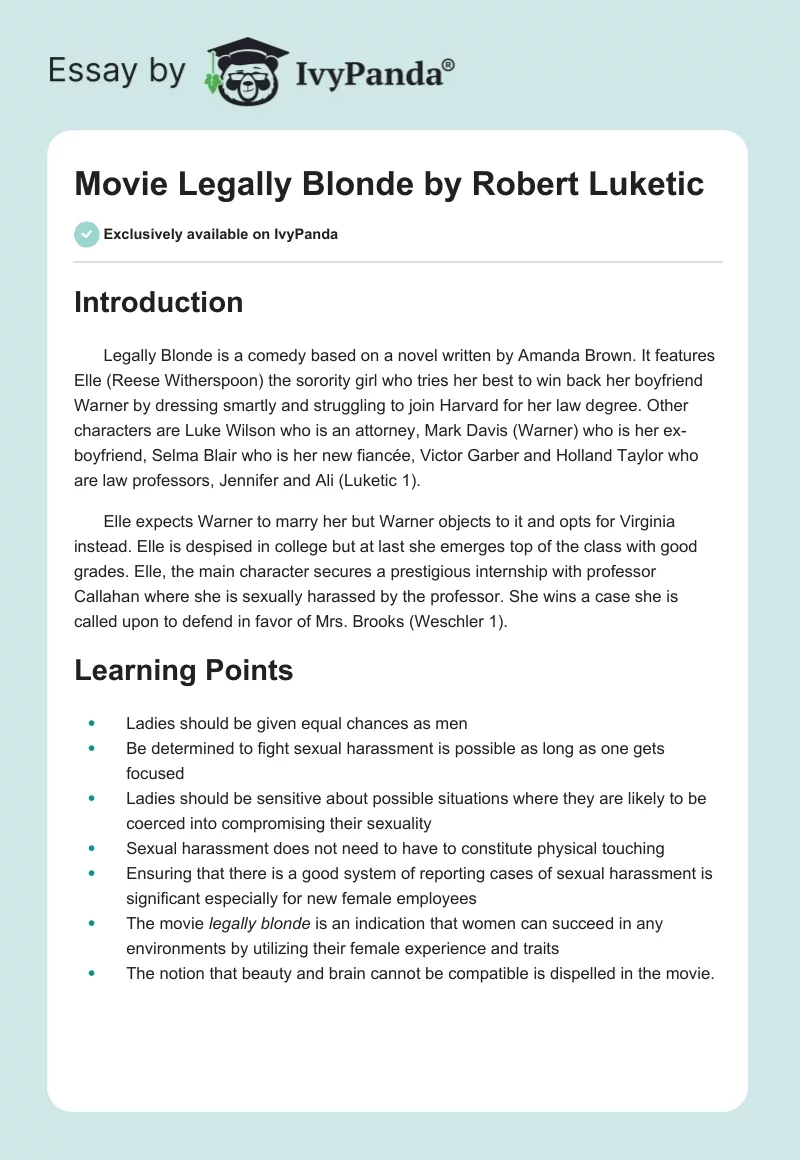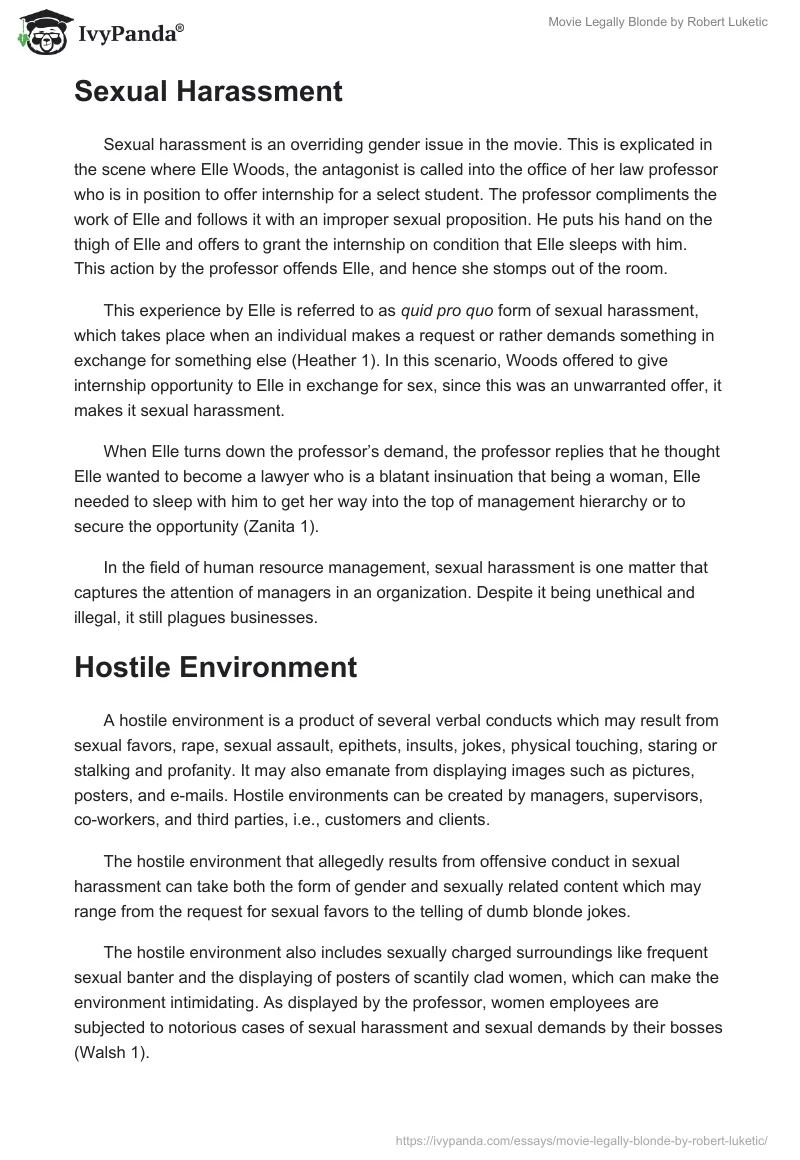Introduction
Legally Blonde is a comedy based on a novel written by Amanda Brown. It features Elle (Reese Witherspoon) the sorority girl who tries her best to win back her boyfriend Warner by dressing smartly and struggling to join Harvard for her law degree. Other characters are Luke Wilson who is an attorney, Mark Davis (Warner) who is her ex-boyfriend, Selma Blair who is her new fiancée, Victor Garber and Holland Taylor who are law professors, Jennifer and Ali (Luketic 1).
Elle expects Warner to marry her but Warner objects to it and opts for Virginia instead. Elle is despised in college but at last she emerges top of the class with good grades. Elle, the main character secures a prestigious internship with professor Callahan where she is sexually harassed by the professor. She wins a case she is called upon to defend in favor of Mrs. Brooks (Weschler 1).
Learning Points
- Ladies should be given equal chances as men
- Be determined to fight sexual harassment is possible as long as one gets focused
- Ladies should be sensitive about possible situations where they are likely to be coerced into compromising their sexuality
- Sexual harassment does not need to have to constitute physical touching
- Ensuring that there is a good system of reporting cases of sexual harassment is significant especially for new female employees
- The movie legally blonde is an indication that women can succeed in any environments by utilizing their female experience and traits
- The notion that beauty and brain cannot be compatible is dispelled in the movie.
Sexual Harassment
Sexual harassment is an overriding gender issue in the movie. This is explicated in the scene where Elle Woods, the antagonist is called into the office of her law professor who is in position to offer internship for a select student. The professor compliments the work of Elle and follows it with an improper sexual proposition. He puts his hand on the thigh of Elle and offers to grant the internship on condition that Elle sleeps with him. This action by the professor offends Elle, and hence she stomps out of the room.
This experience by Elle is referred to as quid pro quo form of sexual harassment, which takes place when an individual makes a request or rather demands something in exchange for something else (Heather 1). In this scenario, Woods offered to give internship opportunity to Elle in exchange for sex, since this was an unwarranted offer, it makes it sexual harassment.
When Elle turns down the professor’s demand, the professor replies that he thought Elle wanted to become a lawyer who is a blatant insinuation that being a woman, Elle needed to sleep with him to get her way into the top of management hierarchy or to secure the opportunity (Zanita 1).
In the field of human resource management, sexual harassment is one matter that captures the attention of managers in an organization. Despite it being unethical and illegal, it still plagues businesses.
Hostile Environment
A hostile environment is a product of several verbal conducts which may result from sexual favors, rape, sexual assault, epithets, insults, jokes, physical touching, staring or stalking and profanity. It may also emanate from displaying images such as pictures, posters, and e-mails. Hostile environments can be created by managers, supervisors, co-workers, and third parties, i.e., customers and clients.
The hostile environment that allegedly results from offensive conduct in sexual harassment can take both the form of gender and sexually related content which may range from the request for sexual favors to the telling of dumb blonde jokes.
The hostile environment also includes sexually charged surroundings like frequent sexual banter and the displaying of posters of scantily clad women, which can make the environment intimidating. As displayed by the professor, women employees are subjected to notorious cases of sexual harassment and sexual demands by their bosses (Walsh 1).
Human Resources Management Theory
Laws are written to protect both the employees and their employers, and the laws reflect the wishes and the values of the society. Supervisors or managers should not, therefore, indulge in behaviors that have serious consequences like incurring costs and damaging litigations. Human rights legislations are paramount to any organization to ensure that all forms of discrimination based on race, gender, and ethnicity are prohibited. Other forms of discrimination take the form of sexual orientation.
Discrimination based on occupational qualification is only permitted in the practice of human resources. Harassment in work place can assume various forms such as threats and intimidation, unwelcome jokes or remarks, display of offensive pictures and making of sexually suggestive remarks. The following are requisites for the human resources department:
- A written policy detailing the definition of sexual harassment and organizations’ commitment towards eradicating or avoiding such harassment
- Statement of duties of all the parties involved
- Clear procedures of launching a complain
- Outline of how complains will be handled
- Communicating the policy to all the parties
In the professor’s law firm, there was manifest sexual harassment which lacked the above requisites, and Elle could not effectively launch complain due to the lack of an established procedures.
An effectively operational human resource management concerns employees’ rights, the rights of the management, employees’ discipline, and work place secrecy. Growing employee rights makes it difficult for employers to discipline workers.
This was replicated in the case of Elle and the professor where despite Elle refusing the sexual demands of the professor, he could not be disciplined. There are numerous cases were violating employee rights might result in numerous suits which can be costly to the organization. Employee rights encompass all potential cases of his/her right to privacy (Stewart and Bohlander 1).
Application of Legally Blonde in the World
The film represents the trappings of post-modernism. Most female characters are portrayed as dumb blondes; this is depicted by the ridiculing of Ellen by her audience and the class mates when they joke about her looks and dressing. Elle uses feminine intuition to gain an advantage in the legal profession.
She proved that one could be a dumb blonde and achieve highest grades in class and also that one can accomplish her goals and actualize in life even if she is a dumb blonde which at first sight might seem inconsistent. Elle is a new kind of girl power and an epitome that one can overcome the trappings of femininity (Mitchell and Reid-Walsh 1).
The film also explains that in the post-feminist age that is characterized by sexual freedom, women’s threat of men is achieved by sexual power and not by joining prestigious universities like Harvard.
As a measure to diffuse the threat from men, Elle creates a character that is manifestly latent with optimism, confidence, and a softened edge. Elle is an epitome of girls who can redeem the image of the society and its institutions with radiant femininity. Manicure also is used to symbolize the transformation of ladies into glamorous images of femininity (Karlyn 1).
The notion that beauty and brain cannot be compatible is dispelled in the movie. It is widely acknowledged in the contemporary world that the two aspects cannot go together. This is only dispelled when Elle wins the court case and makes her proof to the audience in the court that beauty and brain can go together.
Legally blonde demonstrates that women can succeed in law and courtroom practices, which were traditionally a preserve of men due to masculine traits such as aggressiveness and competitiveness. The movie legally blonde is an indication that women can succeed in any environments by utilizing their female experience and traits.
This is brought to fore when Elle disables Chutney’s testimony by applying her knowledge of hair-care rules. Consequently, the bond between Elle and the female law professor is enhanced by the manicurist aspect in the traditional female space of the beauty salon. Also legally blonde softens the feminine image by making it palatable to both men and women (Bergman and Asimow 1).
Another lesson learned from the legally blonde is that individuals should not pay attention to what others say about them and it should not deter them from pursuing what they intend to achieve and also no challenges can deter an individual from reaching his/her heights.
This was demonstrated when Elle overcame all the challenges she faced in her life and all that was said about her by her classmates to emerge the best in her class, the sexual harassment ordeal by her professor and more so to become an accomplished and professional lawyer when she won her first case as an intern in a law firm (Toivonen 1).
A Practical case
One of the female workers in the workplace makes very many personal calls to her boyfriend. When she calls, she does not speak silently but rather loudly to be heard by other employees. In her calls, she often uses very foul and obscene words describing how their night was.
Analysis
The above case qualifies to be a sexual harassment case. Though the calls are not directed to the other employees, it is very clear that the other employees do hear what she talks about and it is very clear that they are not comfortable. This, therefore, creates a very hostile working environment.
Conclusion
The movie legally blonde typifies the modern or contemporary world. It is heavily latent with moral lessons with individual and organizational benefits. Elle is an epitome of the emancipation of women; the quid pro quo sexual harassment characterizes subordinate-supervisor relationship in an organization. The hostile environment that welcomed Elle at the Harvard Law School and the hostile environment that welcomed her at the start of the internship is a reality in the contemporary world.
Works Cited
Bergman, Paul and Asimow, Michael. Reel justice: the courtroom goes to the movies. New York, NY: Andrews McMeel Publishing, 2006. Print.
Heather, Brittany. Sexual harassment in Legally Blonde. Word Press, 2009. Web.
Karlyn, Rowe. Unruly Girls, Unrepentant Mothers: Redefining feminism on screen. Texas, TX: University of Texas Press, 2011. Print.
Luketic, Robert. Legally blonde. MGM Studios, 2001. Web.
Mitchell, Claudie and Reid-Walsh, Jacqueline. Girl Culture: Studying girl culture: a readers’ guide. New York, NY: PublisherABC-CLIO, 2008. Print.
Stewart, Eileen and Bohlander, Monica. Essentials of managing human resources (4th ed). New York, NY: Thomson-nelson, 2007. Print.
Toivonen, Nicole. Representations of women in film and women in the film industry. Building a Better ‘Chick Flick’, 2002. Web.
Walsh, David. Employment law for human resource practice (2nd ed). New York, NY: Cengage Learning, 2006. Print.
Weschler, Raymomd. Legally Blonde. ESL Notes, 2004. Web.
Zanita, Ann. Gender equality in Robert Luketic’s legally blonde: a feminist approach. Eprints, 2008. Web.


